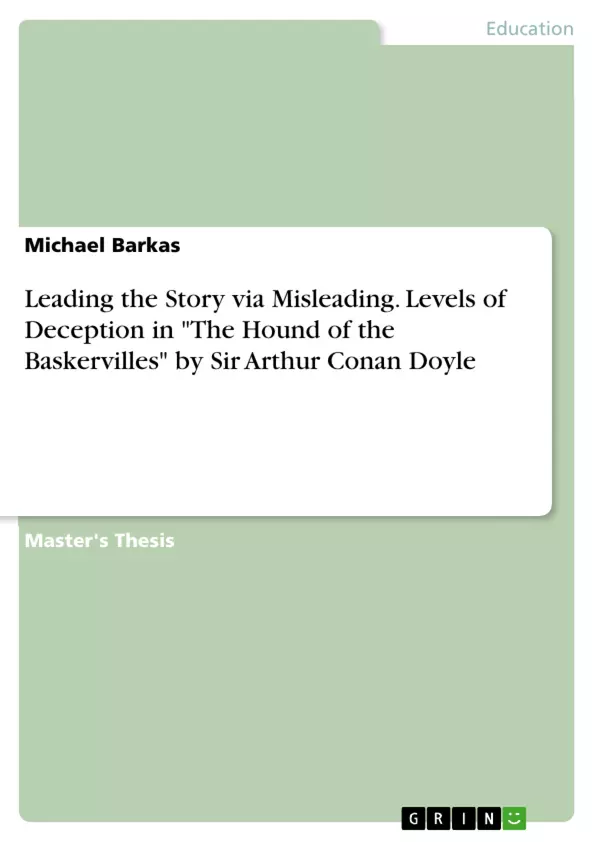The introductory chapter provides a brief retrospection of the "Sherlock Holmes phenomenon" in Doyle's times and in our days. It also offers some important background information on the rise of detective-mystery stories and the socio-political circumstances that necessitated the emergence of a figure like Holmes in the literary scene.
Chapter 2 elaborates on three different levels of deception in "The Hound of the Baskervilles". On one occasion, deception can be said to be synonymous to superstition because it results from lack of observation or sufficient scientific knowledge in order to explain the inexplicable. This type of deception is classified as such due to the constantly advancing scientific achievements, the questioning and decline of Christian faith during the Victorian era, the triumph of rationality over superstition and the more systematic examination of various peculiar phenomena.
To a certain degree, Doyle represents all these because he is a man of science and knows how to "enlighten" or teach the public of his times by using scientific insights and some far-fetched observations and deductions which are performed by his hero. On another occasion, deception is bound to Watson's narrating style. Finally, the third and most explicit type is part of the story's plot. Holmes, on the one hand, lies to Watson and deceives him in order to confront the upcoming danger in utmost secrecy. There is no evil intention here. On the other hand, Jack Stapleton, who represents an impious fraud and wants to gain for his own sake deceives in order to fulfil his crime. His evil intentions render him the main source of deception by means of disguising himself, his wife and his hound so that they look much different than what they are in reality.
Finally, chapter 3 provides some thoughts and conclusions about reading pleasure and reader expectations, but also some critical "rules" that pertain to the reader's involvement in the story. Those "rules" of the later Golden Age of detective fiction were proposed by famous authors, mainly Father Ronald Knox, Raymond Chandler and S. S. Vine, who talked about 'honesty' to the reader, various aesthetic values and the chance to enable a parallel solving of the mystery along with the detective. Nevertheless, a recent approach to this puzzle-solving aspect shows how impossible it is to solve Conan Doyle's mysteries by following certain clues and to arrive at fixed solutions. Examples are offered.
Inhaltsverzeichnis (Table of Contents)
- Preface
- Introduction: The Sherlock Holmes Phenomenon
- The Haunting and Deceiving Text
- Background and Summary
- The Real Curse: Hound or Hoax?
- The Motif of Deception
- Deception Level I: The Author's Deceiving Game
- Deception Level II: The 'Watsonian Narrator'
- Deception Level III
- Holmes and Dr Mortimer's Walking Stick
- No Time for Dartmoor
- Stapleton and his Hound
- Reading Pleasure
- One of the Game's Rules: 'It Must Be Honest with the Reader'
- The Irony Behind the Puzzle-solving Challenge
- Conclusion
Zielsetzung und Themenschwerpunkte (Objectives and Key Themes)
This thesis examines the different levels of deception employed in Arthur Conan Doyle’s The Hound of the Baskervilles, exploring how these levels contribute to the novel’s suspense and intrigue. It analyzes the ways in which the author, the narrator, and even Sherlock Holmes himself mislead the reader, ultimately revealing the true nature of the “supernatural” threat.
- The role of deception in storytelling, particularly in detective-mystery and Gothic horror genres.
- The interplay between the rational and the supernatural in The Hound of the Baskervilles.
- The narrator's influence on the reader's perception of the story.
- The significance of Sherlock Holmes's methods of investigation and his use of deception.
- The impact of reading pleasure and reader expectations on the enjoyment of detective fiction.
Zusammenfassung der Kapitel (Chapter Summaries)
The introductory chapter provides a brief overview of the “Sherlock Holmes phenomenon” in Doyle’s time and its continuing relevance. It also offers background information on the rise of detective-mystery stories and the societal factors that influenced the emergence of Holmes as a literary figure.
Chapter 2 delves into the three distinct levels of deception present in The Hound of the Baskervilles. It explores how the author, through his narrative choices, leads the reader to believe in the existence of a supernatural hound. The chapter also analyzes the narrator's role in deceiving the reader and the way in which Sherlock Holmes's methods of investigation often involve secrecy and deliberate misdirection.
Chapter 3 examines the concept of reading pleasure and how it relates to the reader's involvement in detective fiction. It discusses the “rules” of the Golden Age of detective fiction, including the importance of honesty with the reader, and the challenges of solving Conan Doyle's mysteries.
Schlüsselwörter (Keywords)
The key themes and concepts explored in this thesis include: deception in fiction, detective-mystery, Gothic horror, supernatural elements, the role of the narrator, Sherlock Holmes's methods of investigation, reading pleasure, reader expectations, and the Golden Age of detective fiction.
- Quote paper
- Dipl. Archäologe / B. Ed. Michael Barkas (Author), 2017, Leading the Story via Misleading. Levels of Deception in "The Hound of the Baskervilles" by Sir Arthur Conan Doyle, Munich, GRIN Verlag, https://www.grin.com/document/386176



